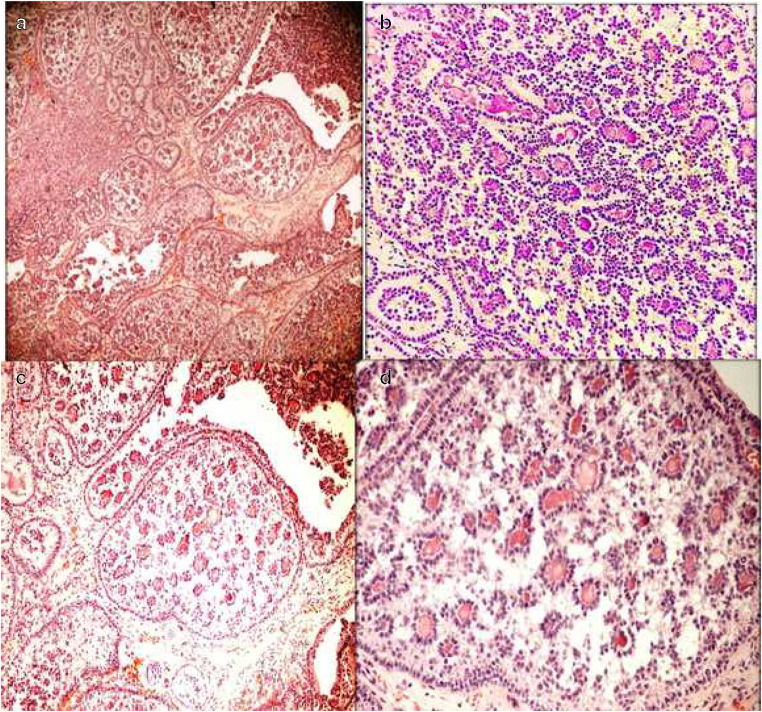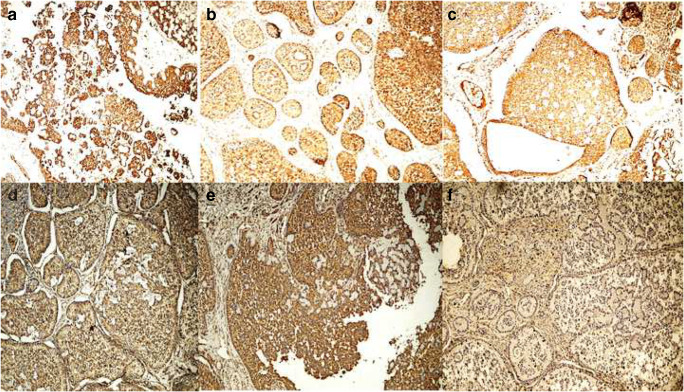Sir,
Sex cord tumor with annular tubules (SCTAT), first described by Scully RE, is a rare ovarian tumor which accounts for only 1.4% of all sex cord stromal tumors of the ovary. About one-third of cases of SCTAT are associated with Peutz-Jeghers syndrome (PJS). The syndromic tumors are more likely to be bilateral and small and behave in a benign fashion. The non-syndromic tumors are large and unilateral and more likely to behave aggressively [1].
A 26-year-old unmarried lady presented to the Gynecology Outpatient Department with complaints of polymenorrhea, pain, and distension of abdomen. On per abdomen examination, a 16-week-size mass was palpable. The mass was firm and non-tender. Subsequent ultrasound abdomen showed an echogenic lesion with internal cystic areas in left adnexa. Contrast enhanced computed tomography (CECT) abdomen showed a heterogeneously enhancing predominantly solid lesion in left adnexa measuring 8.5 × 16.1 × 11.4 cm. The uterus and cervix were normal. Tumor markers CA125, serum LDH, serum alpha fetoprotein (AFP), and carcinoembryonic antigen (CEA) were within normal limits. Serum inhibin levels were elevated at 209 pg/ml. Exploratory laparotomy with left salpingo-oophorectomy was done. Omental and peritoneal biopsies were taken. Grossly, the ovarian tumor mass was solid and cystic with large areas of hemorrhage.
On microscopy, the tumor was composed of circumscribed ring–shaped tubules with peripherally oriented nuclei with central hyalinized basement membrane–like material. Both simple and complex tubules were noted. The nuclei had vesicular chromatin and grooves. No germ cell component was seen [Fig. 1a–d]. On immunohistochemistry, the tumor cells were immunopositive for inhibin, calretinin, CD99, CD10, and vimentin and negative for pan cytokeratin. The Ki 67 index was 14% [Fig. 2a–f].
Fig. 1.
Hematoxylin and eosin (a × 40, b × 400, c × 100, d × 400). The tumor was composed of circumscribed ring–shaped tubules with peripherally oriented nuclei with central hyalinized basement membrane–like material. Both simple and complex tubules were noted. The nuclei had vesicular chromatin and grooves
Fig. 2.
Immunohistochemistry. The tumor was immunopositive for inhibin (a × 400), calretinin (b × 400), CD99 (c × 400), vimentin (d × 400), and CD10 (e × 400). The Ki67 index was 14% (f × 400)
The patient did not show features of Peutz-Jegher’s syndrome. Final diagnosis was non-syndromic sex cord stromal tumor with annular tubules with peritoneal tumor deposit. Two months after the surgery, the patient developed tumor recurrence with a 2 × 1-cm solid enhancing lesion in left adnexa and mesenteric deposits. A complete recurrent tumor resection was performed at some other center and the patient was tumor-free at 2 months follow-up.
A complete tumor resection has been the mainstay of treatment for recurrent and malignant cases. However, recently, taxane plus bevacizumab has been tried in cases not amenable to complete resection [2]. Almost all the SCTATs arise from the ovary with only rare extraovarian and testicular tumors been reported [3, 4]. Histogenetically, these tumors have features intermediate between granulosa cell tumors and Sertoli cell tumors. Adenoma malignum of the cervix is also associated with Peutz-Jeghers syndrome and sometimes occurs in conjunction with SCTAT [5].
To conclude, SCTAT should be included in the differential diagnosis of sex cord stromal tumors even in the absence of features of PJ syndrome given the higher potential for aggressive behavior in such cases.
Compliance with Ethical Standards
Conflict of Interest
The authors declare that they have no conflict of interest.
Informed Consent
Informed written consent was taken from the patient for publication of case details.
Footnotes
Publisher’s Note
Springer Nature remains neutral with regard to jurisdictional claims in published maps and institutional affiliations.
Contributor Information
Farah Choudhary, Email: drfarah187@gmail.com.
Nadeem Tanveer, Email: ntobh104@yahoo.co.in.
Gunjan Mangla, Email: manglagunjan@gmail.com.
Aishwary Gayatree, Email: agaish61@gmail.com.
References
- 1.Qian Q, You Y, Yang J, Cao D, Zhu Z, Wu M, Chen J, Lang J, Shen K. Management and prognosis of patients with ovarian sex cord tumor with annular tubules: a retrospective study. BMC Cancer. 2015;15:270. doi: 10.1186/s12885-015-1277-y. [DOI] [PMC free article] [PubMed] [Google Scholar]
- 2.Sho T, Yanazume S, Fukuda M, Togami S, Kamio M, Kobayashi H. Impact of taxane plus bevacizumab for ovarian sex cord tumor with annular tubules. J Obstet Gynaecol Res. 2019;45(7):1423–1428. doi: 10.1111/jog.13985. [DOI] [PubMed] [Google Scholar]
- 3.Jaegle WT, Keyser EA, Messersmith L, Brady RO, Miller C. Extraovarian sex cord tumor with annular tubules discovered arising from a leiomyoma. Gynecol Oncol Rep. 2018;26:17–20. doi: 10.1016/j.gore.2018.06.013. [DOI] [PMC free article] [PubMed] [Google Scholar]
- 4.Nigam S, Gupta V, Sarda AK. Testicular tumour with features of sex cord tumor with annular tubules associated with cryptorchidism and infertility--a case report. Indian J Pathol Microbiol. 2004;47(4):549–551. [PubMed] [Google Scholar]
- 5.Young RH, Welch WR, Dickersin GR, Scully RE. Ovarian sex cord tumor with annular tubules: review of 74 cases including 27 with Peutz-Jeghers syndrome and four with adenoma malignum of the cervix. Cancer. 1982;50(7):1384–1402. doi: 10.1002/1097-0142(19821001)50:7<1384::aid-cncr2820500726>3.0.co;2-5. [DOI] [PubMed] [Google Scholar]




